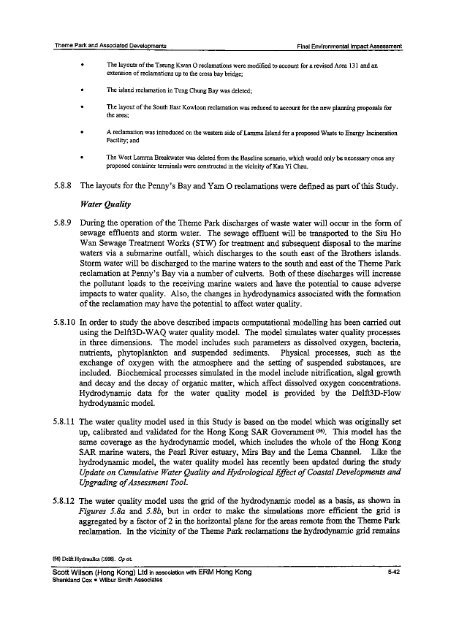mm^j - HKU Libraries
mm^j - HKU Libraries
mm^j - HKU Libraries
- No tags were found...
You also want an ePaper? Increase the reach of your titles
YUMPU automatically turns print PDFs into web optimized ePapers that Google loves.
Theme Park and Associated DevelopmentsFinal Environmental Impact Assessment• The layouts of the Tseung Kwan O reclamations were modified to account for a revised Area 131 and anextension of reclamations up to the cross bay bridge;• The island reclamation in Tung Chung Bay was deleted;• The layout of the South East Kowloon reclamation was reduced to account for the new planning proposals forthe area;• A reclamation was introduced on the western side of Lamma Island for a proposed Waste to Energy IncinerationFacility; and• The West Lamma Breakwater was deleted from the Baseline scenario, which would only be necessary once anyproposed container terminals were constructed in the vicinity of Kau Yi Chau.5.8.8 The layouts for the Penny's Bay and Yam O reclamations were defined as part of this Study.Water Quality5.8.9 During the operation of the Theme Park discharges of waste water will occur in the form ofsewage effluents and storm water. The sewage effluent will be transported to the Siu HoWan Sewage Treatment Works (STW) for treatment and subsequent disposal to the marinewaters via a submarine outfall, which discharges to the south east of the Brothers islands.Storm water will be discharged to the marine waters to the south and east of the Theme Parkreclamation at Penny's Bay via a number of culverts. Both of these discharges will increasethe pollutant loads to the receiving marine waters and have the potential to cause adverseimpacts to water quality. Also, the changes in hydrodynamics associated with the formationof the reclamation may have the potential to affect water quality.5.8.10 In order to study the above described impacts computational modelling has been carried outusing the Delft3D-WAQ water quality model. The model simulates water quality processesin three dimensions. The model includes such parameters as dissolved oxygen, bacteria,nutrients, phytoplankton and suspended sediments. Physical processes, such as theexchange of oxygen with the atmosphere and the setting of suspended substances, areincluded. Biochemical processes simulated in the model include nitrification, algal growthand decay and the decay of organic matter, which affect dissolved oxygen concentrations.Hydrodynamic data for the water quality model is provided by the Delft3D-Flowhydrodynamic model.5.8.11 The water quality model used in this Study is based on the model which was originally setup, calibrated and validated for the Hong Kong SAR Government < 56 ). This model has thesame coverage as the hydrodynamic model, which includes the whole of the Hong KongSAR marine waters, the Pearl River estuary, Mirs Bay and the Lema Channel. Like thehydrodynamic model, the water quality model has recently been updated during the studyUpdate on Cumulative Water Quality and Hydrological Effect of Coastal Developments andUpgrading of Assessment Tool.5.8.12 The water quality model uses the grid of the hydrodynamic model as a basis, as shown inFigures 5.8a and 5.56, but in order to make the simulations more efficient the grid isaggregated by a factor of 2 in the horizontal plane for the areas remote from the Theme Parkreclamation. In the vicinity of the Theme Park reclamations the hydrodynamic grid remains(56) Delft Hydraulics (1998). Op cit.Scott Wilson (Hong Kong) Ltd in association with 5-42Shankland Cox • Wilbur Smith Associates
















